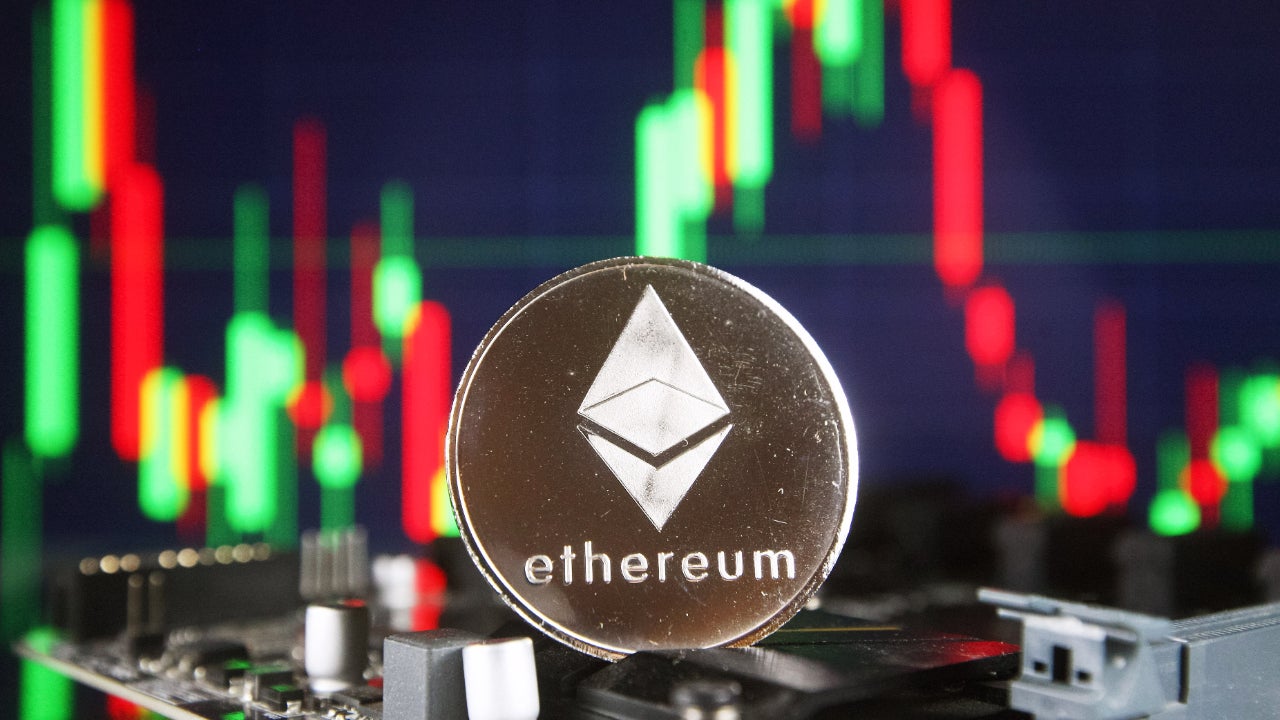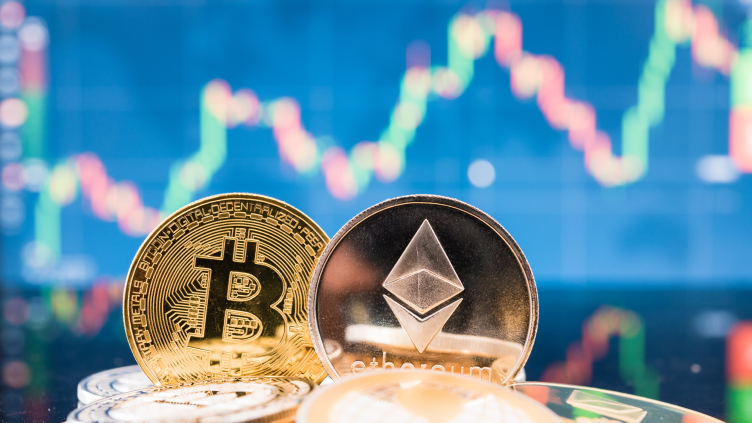Ethereum
What is Ethereum and how does it work?

Ethereum is a type of digital currency or cryptocurrency, a medium of exchange that exists exclusively online. Ethereum is among the most popular cryptocurrencies in the world and ranks second in total size (as of May 2024), behind Bitcoina coin that has become synonymous with crypto.
Cryptocurrency has sparked a lot of controversy, from those who see it as the world’s next payment system to those who simply see it as a speculative bubble. Here’s what Ethereum is and how it works.
What is Ethereum?
Ethereum is one of thousands of cryptocurrencies that have emerged over the past few years. Born from the brainchild of eight co-founders, Ethereum debuted in 2015. cryptocurrency or the platform is called Ethereum, while the individual unit is called an ether (2 ether, 17 ether, etc.)
Ethereum operates on a decentralized computer network, or distributed ledger called blockchain, which manages and tracks the currency. It can be helpful to think of a blockchain as a running receipt of every transaction made in cryptocurrency. Computers on the network verify transactions and ensure data integrity.
This decentralized network is part of the appeal of Ethereum and other cryptocurrencies. Users can exchange money without the need for a central intermediary such as a bank, and the lack of a central bank means the currency is almost self-sustaining. Ethereum also allows users to transact almost anonymously, even if the transaction is publicly available on the blockchain.
Although the entire field is discussed in terms of currency, it may be more useful to think of crypto as a token that can be spent for a specific purpose enabled by the Ethereum platform. For example, sending money or buying and selling goods are functions enabled by the coin. But Ethereum can do much more and can also serve as a basis for smart contracts and other applications.
What does Ethereum do?
Ethereum can power a number of applications offering a wide range of functions:
- Currency: With a cryptocurrency wallet, you can send and receive ether or pay for goods and services, if digital currency is accepted as payment. Some platforms, like Coinbase, allow you to store your coins securely. digital wallet, so you can make them less exposed to hackers, in theory.
- Decentralized applications, or dApps: Ethereum powers digital applications that allow users to play games, invest, send money, track an investment portfolio, follow social media and much more.
- Smart contracts: Smart contracts are a kind of permissionless application that runs automatically when the conditions of the contract are met. They play a central role in dApps built on Ethereum.
- Non-fungible tokens: These tokens can be powered by Ethereum and allow artists or others to sell art or other items directly to buyers using smart contracts.
- Decentralized finance: By using Ethereum, some people can avoid centralized (government) control over the movement of money or other assets.
Again, it might be more accurate to think of Ethereum as a token that powers various applications rather than just a cryptocurrency that allows users to send money to each other.
Where do ether coins come from?
New ether coins are created when owners validate transactions in the currency. Ether coins are created using what is called a “proof of stake” process. In this process, the cryptocurrency relies on the owners of the coin, the stakeholders, to validate transactions in the cryptocurrency. In return, validators earn rewards in the form of ether coins. But validators could also lose coins if they approve fraudulent transactions or try to cheat the system.
Validators must have a significant interest in crypto to participate. But even small investors can participate in the staking system and earn rewards by pledging their coins to a validator.
To issue new coins and manage its system, Ethereum once used a “proof of work” process, like that used by Bitcoin. In this process, the decentralized crypto network performs complex mathematical calculations to “mine” crypto coins. In September 2022, Ethereum moved from a proof-of-work process to a proof-of-stake process, in a team called The Merge.
A proof-of-stake process is much more energy efficient than a proof-of-work process. One of the main criticisms of Bitcoin is the amount of energy it spends running its system. A proof-of-stake process can also enable faster and larger transactions.
The total annual ether emission is limited. As of May 2024, there are approximately 120.1 million ether in existence. This stands in stark contrast to Bitcoin, where a maximum of 21 million coins can be created and new issuance becomes more difficult every year. And this contrasts even more with Dogecoin, where the emission is completely unlimited. Experts estimate that annual ether issuance has fallen by around 87% since adopting a proof-of-stake system.
Ethereum ETF approved
At the end of May 2024, the United States Securities and Exchange Commission (SEC) approved in principle the trading of Ethereum spot exchange-traded funds (ETFs). The move is a key step on the path to listing individual ETFs on the New York Stock Exchange and Nasdaq. However, the SEC has not yet approved fund companies to issue these Ethereum ETFs.
Spot ETFs directly track the price of the underlying asset, in this case, Ethereum. Investors can buy and sell shares of the ETF on exchanges, gaining exposure to Ethereum’s price movements without needing to directly buy and hold the cryptocurrency itself.
These ETFs would provide investors with a regulated and more familiar way to trade Ethereum. Supporters believe they will lead to wider adoption and increased investment in crypto. The price of ether soared following the approval of Bitcoin ETFs in January 2024, in anticipation of the subsequent approval of Ethereum ETFs by the SEC.
Is Ethereum a good investment?
Ethereum has grown significantly over the past few years, so those who bought and held years ago have done well. But rather than looking at yesterday’s price movements and being afraid of missing out, it’s important to understand what you’re investing in. And based on this, those who buy Ethereum are buying a cryptocurrency that is not backed by any physical asset or cash flow. .
This may seem trivial, but it is the main difference between stocks and cryptocurrencies. A stock is fractional ownership in a company, so its performance over time is due to the continued success of that company. If the company grows its profits, its shares will likely follow that growth over time. Shareholders own a legal stake in the assets and cash flows of that company.
On the other hand, Ethereum – and most other popular cryptocurrencies – are not supported by anything at all. The only thing holding the price up is the optimism of other investors, who all believe that they will be able to sell the cryptocoin for more money later to someone else – the so-called “theory of more big fool” of investment. Speculation is the only thing driving Ethereum and other cryptos higher.
For this reason, among others, investing legend Warren Buffett won’t touch cryptocurrency and even publicly stated that he called it “rat poison squared.”
Should you buy or stake Ethereum?
If you’re looking to speculate on Ethereum, it’s simple to buy and trade the cryptocurrency on a popular trading platform such as Robin Hood Or Binance.US. You can access the market 24 hours a day and you will benefit from good liquidity, meaning you can trade without moving the price too much. Calculating profit is also simple: you profit when you sell coins for more than you paid for them.
If you are considering betting on Ethereum, you have several options. More advanced users can participate in solo staking, which requires running your own validator. You’ll need technical expertise, a large position (usually a minimum of 32 ether), and dedicated hardware.
A more accessible option is to participate in a staking pool. You contribute your ether to a pool with other investors, and rewards are distributed proportionally based on your contribution. Some crypto exchanges also offer staking serviceswhich are convenient, but can generate lower returns.
Ultimately, buying Ethereum is easier than staking it and requires less effort.
Conclusion
Speculators can invest directly in cryptocurrencies such as Ethereum, but they can also invest in companies that could benefit from the move towards digital currencies.
Whether you trade Ethereum, Bitcoin, or any other cryptocurrency, it is essential to understand the risks, including the potential loss of your entire investment. Investors should take a measured approach to cryptocurrencies, given their volatility and numerous risks. Those looking to get a taste of the action shouldn’t invest more than they can afford to lose.
Editorial Disclaimer: All investors are advised to conduct their own independent research into investment strategies before making an investment decision. Furthermore, investors are advised that past performance of investment products is not a guarantee of future price appreciation.
Ethereum
QCP sees Ethereum as a safe bet amid Bitcoin stagnation

QCP, a leading trading firm, has shared key observations on the cryptocurrency market. Bitcoin’s struggle to surpass the $70,000 mark has led QCP to predict Selling pressure is still strong, with BTC likely to remain in a tight trading range. In the meantime, Ethereum (ETH) is seen as a more promising investment, with potential gains as ETH could catch up to BTC, thanks to decreasing ETHE outflows.
Read on to find out how you can benefit from it.
Bitcoin’s Struggle: The $70,000 Barrier
For the sixth time in a row, BTC has failed to break above the $70,000 mark. Bitcoin is at $66,048 after a sharp decline. Many investors sold Bitcoin to capitalize on the rising values, which caused a dramatic drop. The market is becoming increasingly skeptical about Bitcoin’s rise, with some investors lowering their expectations.
Despite the continued sell-off from Mt. Gox and the US government, the ETF market remains bullish. There is a notable trend in favor of Ethereum (ETH) ETFs as major bulls have started investing in ETFs, indicating a bullish sentiment for ETH.
QCP Telegram Update UnderlinesIncreased market volatility. The NASDAQ has fallen 10% from its peak, led by a pullback in major technology stocks. Currency carry trades are being unwound and the VIX, a measure of market volatility, has jumped to 19.50.
The main factors driving this uncertainty are Value at Risk (VaR) shocks, high stock market valuations and global risk aversion sentiment. Commodities such as oil and copper have also declined on fears of an economic slowdown.
Additionally, QCP anticipates increased market volatility ahead of the upcoming FOMC meeting, highlighting the importance of the Federal Reserve’s statement and Jerome Powell’s subsequent press conference.
A glimmer of hope
QCP notes a positive development in the crypto space with an inflow of $33.7 million into ETH spot ETFs, which is giving a much-needed boost to ETH prices. However, they anticipate continued outflows of ETHE in the coming weeks. The recent Silk Road BTC moves by the US government have added to the market uncertainty.
QCP suggests a strategic trade involving BTC, which will likely remain in its current range, while ETH offers a more promising opportunity. They propose a trade targeting a $4,000-$4,500 range for ETH, which could generate a 5.5x return by August 30, 2024.
Ethereum
Ethereum Whale Resurfaces After 9 Years, Moves 1,111 ETH Worth $3.7 Million

An Ethereum ICO participant has emerged from nearly a decade of inactivity.
Lookonchain, a smart on-chain money tracking tool, revealed On X, this long-inactive participant recently transferred 1,111 ETH, worth approximately $3.7 million, to a new wallet. This significant move marks a notable on-chain movement, given the participant’s prolonged dormancy.
The Ethereum account in question, identified as 0xE727E67E…B02B5bFC6, received 2,000 ETH on the Genesis block over 9 years ago.

This initial allocation took place during the Ethereum ICOwhere the participant invested in ETH at around $0.31 per coin. The initial investment, worth around $620 at the time, has now grown to millions of dollars.
Recent Transactions and Movements
The inactive account became active again with several notable output transactions. Specifically, the account transferred 1,000 ETH, 100 ETH, 10 ETH, 1 ETH, and 1 more ETH to address 0x7C21775C…2E9dCaE28 within a few minutes. Additionally, it moved 1 ETH to 0x2aa31476…f5aaCE9B.
Additionally, in the latest round of transactions, the address transferred 737,995 ETH, 50 ETH, and 100 ETH, for a total of 887,995 ETH. These recent activities highlight a significant movement of funds, sparking interest and speculation in the crypto community.
Why are whales reactivating?
It is also evident that apart from 0xE727E67E…B02B5bFC6, other previously dormant Ethereum whales are waking up with significant transfers.
In May, another dormant Ethereum whale made headlines when it staked 4,032 ETHvalued at $7.4 million, after more than two years of inactivity. This whale initially acquired 60,000 ETH during the Genesis block of Ethereum’s mainnet in 2015.
At the time, this activity could have been related to Ethereum’s upgrade known as “Shanghai,” which improved the network’s scalability and performance. This whale likely intended to capitalize on the price surge that occurred after the upgrade.
Disclaimer: This content is informational and should not be considered financial advice. The opinions expressed in this article may include the personal opinions of the author and do not reflect the opinion of The Crypto Basic. Readers are encouraged to conduct thorough research before making any investment decisions. The Crypto Basic is not responsible for any financial losses.
-Advertisement-
Ethereum
Only Bitcoin and Ethereum are viable for ETFs in the near future

BlackRock: Only Bitcoin and Ethereum Are Viable for ETFs in the Near Future
Bitcoin and Ethereum will be the only cryptocurrencies traded via ETFs in the near future, according to Samara Cohen, chief investment officer of ETFs and indices at BlackRock, the world’s largest asset manager.
In an interview with Bloomberg TV, Cohen explained that while Bitcoin and Ethereum have met BlackRock’s rigorous criteria for exchange-traded funds (ETFs), no other digital asset currently comes close. “We’re really looking at the investability to see what meets the criteria, what meets the criteria that we want to achieve in an ETF,” Cohen said. “Both in terms of the investability and from what we’re hearing from our clients, Bitcoin and Ethereum definitely meet those criteria, but it’s going to be a while before we see anything else.”
Cohen noted that beyond the technical challenges of launching new ETFs, the demand for other crypto ETFs, particularly Solana, is not there yet. While Solana is being touted as the next potential ETF candidate, Cohen noted that the market appetite remains lacking.
BlackRock’s interest in Bitcoin and Ethereum ETFs comes after the successful launch of Ethereum ETFs last week, which saw weekly trading volume for the crypto fund soar to $14.8 billion, the highest level since May. The success has fueled speculation about the next possible ETF, with Solana frequently mentioned as a contender.
Solana, known as a faster and cheaper alternative to Ethereum, has been the subject of two separate ETF filings in the US by VanEck and 21Shares. However, the lack of CME Solana futures, unlike Bitcoin and Ethereum, is a significant hurdle for SEC approval of a Solana ETF.
Despite these challenges, some fund managers remain optimistic about Solana’s potential. Franklin Templeton recently described Solana as an “exciting and major development that we believe will drive the crypto space forward.” Solana currently accounts for about 3% of the overall cryptocurrency market value, with a market cap of $82 billion, according to data from CoinGecko.
Meanwhile, Bitcoin investors continue to show strong support, as evidenced by substantial inflows into BlackRock’s iShares Bitcoin Trust (NASDAQ: IBIT). On July 22, IBIT reported inflows of $526.7 million, the highest single-day total since March. This impressive haul stands in stark contrast to the collective inflow of just $6.9 million seen across the remaining 10 Bitcoin ETFs, according to data from Farside Investors. The surge in IBIT inflows coincides with Bitcoin’s significant $68,000 level, just 8% off its all-time high of $73,000.
Ethereum
Ethereum Posts First Consecutive Monthly Losses Since August 2023 on New ETFs

Available exclusively via
Bitcoin ETF vs Ethereum: A Detailed Comparison of IBIT and ETHA
Andjela Radmilac · 3 days ago
CryptoSlate’s latest market report takes an in-depth look at the technical and practical differences between IBIT and BlackRock’s ETHA to explain how these products work.
-

 Ethereum12 months ago
Ethereum12 months agoEthereum Posts First Consecutive Monthly Losses Since August 2023 on New ETFs
-

 Regulation12 months ago
Regulation12 months agoCryptocurrency Regulation in Slovenia 2024
-

 News12 months ago
News12 months agoNew bill pushes Department of Veterans Affairs to examine how blockchain can improve its work
-

 Regulation12 months ago
Regulation12 months agoThink You Own Your Crypto? New UK Law Would Ensure It – DL News
-

 Regulation12 months ago
Regulation12 months agoUpbit, Coinone, Bithumb Face New Fees Under South Korea’s Cryptocurrency Law
-

 Regulation12 months ago
Regulation12 months agoA Blank Slate for Cryptocurrencies: Kamala Harris’ Regulatory Opportunity
-

 Regulation12 months ago
Regulation12 months agoBahamas Passes Cryptocurrency Bill Designed to Prevent FTX, Terra Disasters
-

 Regulation12 months ago
Regulation12 months agoIndia to Follow G20 Policy for Cryptocurrency Regulation: MoS Finance
-

 News1 year ago
News1 year ago“Captain Tsubasa – RIVALS” launches on Oasys Blockchain
-

 Ethereum1 year ago
Ethereum1 year agoComment deux frères auraient dérobé 25 millions de dollars lors d’un braquage d’Ethereum de 12 secondes • The Register
-

 News12 months ago
News12 months agoEU supports 15 startups to fight online disinformation with blockchain
-

 News1 year ago
News1 year agoSolana ranks the fastest blockchain in the world, surpassing Ethereum, Polygon ⋆ ZyCrypto













